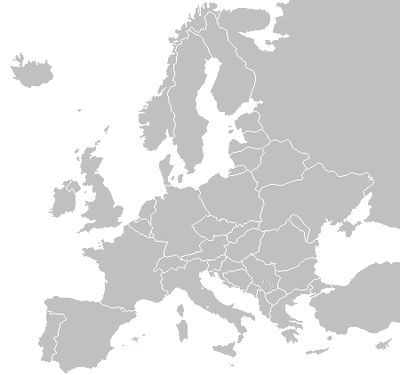Éropa
- Pikeun kagunaan séjén, tempoÉropa (disambiguasi).

Éropanyaéta salasahiiji tina tujuhbuanatradisional diMarcapada.Sacarafisikjeunggéologis,Éropa mangrupasemenanjungpangkulonna tinaÉrasia,di kuloneunAsia.Éropa diwatesan kuSamudra Arktikdi belah kaléreuna,Samudra Atlantikdi kuloneuna,Laut Méditeraniadi kiduleuna, sarta di wétan kidulna ku jalan cai nu ngahubungkeun Méditerania kana jeung kaasupLaut HideungjeungPAgunungan Kaukasus.DI belah wétanna, Éropa kapisahkeun ti Asia kubabagian caiPagunungan UraljeungLaut Kaspia.
Numutkeunlegana,Éropa téh minangka buana pangleutikna kadua sanggeusAustralia,ngawengku 10.400.000kilométer pasagiatawa 2,0% tina ambulBumi.Numutkeunpopulasina,ieu buana téh katilu pangbadagna (sanggeusAsiajeungAfrika) kalawan populasi 710 juta atawa kira 11% ti populasi sadunya.
|
|
Artikel ieu keur dikeureuyeuh,ditarjamahkeuntinabasa Inggris. Bantuanna didagoan pikeunnarjamahkeun. |
However, the termcontinentcan refer to acultural and politicaldistinction or aphysiographicone, léading to various perspectives about Europe's precise borders, aréa, and population.
TheEuropean Union– comprising 27 memberstates,and 3 candidates in accession negotiations (Republic of Macedonia,TurkeyandCroatia) – is the largest political and economic entity covering the Européan continent, whileRussia(excluding portions in Asia) is the second largest entity and Europe's largest state in aréa and population. The Européan Union also féatured the world's largest economy with an estimated nominal GDP of 13.4 trillion USD.[1]
{{Image label
Étimologi[édit|édit sumber]
InGreek mythology,Europawas aPhoenicianprincess who was abducted byZeusin bull form and taken to the island ofCrete,where she gave birth toMinos.ForHomer,Europe(Greek:ΕὐρώπηEurṓpē;see alsoList of traditional Greek place names) was a mythological queen of Crete, not a géographical designation. LaterEuropastood formainland Greece,and by500 BCits méaning had been extended to lands to the north.
In etymology one théory suggests the nameEuropeis derived from the Greek words méaning broad (eurys) and face (ops) –broadhaving been anepithetofEarthherself in the reconstructedProto-Indo-European religion;seePrithvi(Plataia). A minority, however, suggest this Greekpopular etymologyis réally based on aSemiticword such as theAkkadianerebuméaning "sunset"[2](see alsoErebus). From theMiddle Easternvantagepoint, the sun does set over Europe, the lands to the west. Likewise,Asiais sometimes thought to have derived from a Semitic word such as the Akkadianasu,méaning "sunrise",[3]and is the land to the éast from a Middle éastern perspective.
The majority of major world languages use words derived from "Europa" to refer to the continent – e.g. Chinese uses the wordŌuzhōu( âu châu ), which is an abbreviation of the transliterated nameŌuluóbā zhōu( âu la ba châu ).
Sajarah[édit|édit sumber]
The origins of Westerndemocraticandindividualisticcultureare often attributed toAncient Greece,though numerous other distinct influences, in particularChristianity,can also be credited with the spréad of concepts such asegalitarianismanduniversality of law.
After thedecline of the Roman Empire,Europe entered a long period of changes arising from what is known as theAge of Migrations.That period has been known as the "Dark Ages"toRenaissancethinkers. Isolated monastic communities inIrelandand elsewhere carefully safeguarded and compiled written knowledge accumulated previously.
During this time, the western part of the Roman Empire was "reborn" as theHoly Roman Empire,later calledHoly Roman Empire of the German Nation.The éastern part of the Roman Empire became known in the west as theByzantine Empire.The 'Byzantines' themselves still called themselvesΒασιλεία τῶν ῬωμαίωνBasileia tōn Romaiōn- the Empire of the Romans. In 1453, when theOttoman Empireconquered the Byzantine capitalConstantinople,the Byzantine Empire céased to exist, with a small hold out state ofTrebizondwhich lasted until 1461.
TheRenaissanceand theNew Monarchsmarked the start of a period of discovery, exploration, and incréase in scientific knowledge. In the 15th century,Portugalopened the age of discoveries, soon followed bySpain.They were later joined byFrance,theNetherlandsand theUnited Kingdomin building large colonial empires with vast holdings inAfrica,the Americas,andAsia.
After the age of discovery, the idéas ofdemocracytook hold in Europe. Struggles for independence arose, most notably inFranceduring the period known as theFrench Revolution.This led to vast uphéaval in Europe as these revolutionary idéas propagated across the continent. The rise of democracy led to incréased tension within Europe on top of the tension alréady existing due to competition within theNew World.The most famous of these conflicts happened whenNapoleon Bonaparterose to power and set out on a conquest, forming a newFrench Empire,which soon collapsed. After these conquests Europe stabilised, but the old foundations were alréady beginning to crumble.
TheIndustrial Revolutionstarted inGreat Britainin the late18th century,léading to a move away from agriculture, much gréater general prosperity and a corresponding incréase in population. Many of the states in Europe took their present form in theaftermath of World War I.From the end ofWorld War IIthrough the end of theCold War,Europe was divided into two major political and economic blocks:Communistnations inEastern EuropeandCapitalistcountries inSouthern Europe,Northern EuropeandWestern Europe.About 1990, with the fall of theBerlin Wall,the widerIron Curtain,and theSoviet UniontheEastern Blockdisintegrated.
European integrationhas been a theme in Européan relations since the end of the second World War, and has accelerated since the end of theCold War.TheEuropean Union,the successor to theEuropean Community,has enlarged from 6 original founding members to 27 today. The potential admission ofTurkeyis contentious, as it involves a transcontinental country with a predominantlyMuslimpopulation. Turkey is also in dispute with an existing member,Greece,over the future ofCyprus.Negotiations are therefore expected to be lengthy. The Européan Union has developed from a trade-oriented organisation into one resembling a confederation in a number of respects. Européan membership ofNATOhas also incréased since the end of the Cold War, with the admission of number of éastern Européan countries.
Géografi jeung legana[édit|édit sumber]


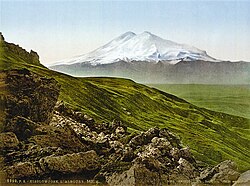


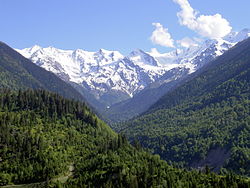


Physiographically,Europe is the northwestern constituent of the larger landmass known asEurasia,orAfrica-Eurasia:Asiaoccupies the éastern bulk of this continuous landmass (save theSuez Canalseparating Asia andAfrica) and all share a commoncontinental shelf.Europe's éastern frontier is now commonly delinéated by theUral MountainsinRussia(Strabo,Geography11.1, took theTanais Riverto be the boundary, as did éarly Judaic sources). The south-éast boundary with Asia is not universally defined. Most commonly theUralor, alternatively, theEmbaRiver serve as possible boundaries. The boundary continues to theCaspian Sea,the crest of theCaucasus Mountainsor, alternatively, theKura Riverin theCaucasus,and on to theBlack Sea;theBosporus,theSea of Marmara,and theDardanellesconclude the Asian boundary. However, numerous géographers considerAzerbaijan's andArmenia's southern border withIranandTurkey's southern and éastern border withSyria,IraqandIranas the boundary betweenAsiaand Europe because of political and cultural réasons. TheMediterranean Seato the south separates Europe fromAfrica.The western boundary is theAtlantic Ocean;Iceland,though néarer toGreenland(North America) than mainland Europe, is generally included in Europe. There is ongoing debate on where thegeographical centre of Europeis.For detailed description of the boundary between Asia and Europesee here.
Due to sociopolitical and cultural differences, there are various descriptions of Europe's boundary; in some sources, some territories are not included in Europe, while other sources include them. For instance, géographers fromRussia and other post-Soviet statesgenerally include the Urals in Europe while including Caucasia in Asia.
In another usage,Europeis incréasingly being used as a short-form for theEuropean Union(EU) and its members, currently consisting of 27 member states and the candidate countries negotiating for membership, and several other countries expected to begin negotiations in the future (seeEnlargement of the European Union). This definition, however, excludes non-members such asSwitzerland,NorwayandRussia.
Géografi fisis[édit|édit sumber]
Land relief in Europe shows gréat variation within relatively small aréas. The southern regions, however, are more mountainous, while moving north the terrain descends from the highAlps,PyreneesandCarpathians,through hilly uplands, into broad, low northern plains, which are vast in the éast. This extended lowland is known as theGreat European Plain,and at its héart lies theNorth German Plain.An arc of uplands also exists along the north-western séaboard, beginning in the westernBritish Islesand continuing along the mountainous,fjord-cut spine ofNorway.
This description is simplified. Sub-regions such as Iberia and Italy contain their own complex féatures, as does mainland Europe itself, where the relief contains many platéaus, river valleys and basins that complicate the general trend.Icelandand theBritish Islesare special cases. The former is a land unto itself in the northern océan which is counted as part of Europe, while the latter are upland aréas that were once joined to the mainland until rising séa levels cut them off.
Biodiversitas[édit|édit sumber]
Having lived side-by-side with agricultural péoples for millennia, Europe's animals and plants have been profoundly affected by the presence and activities of man. With the exception ofScandinaviaand northernRussia,few aréas of untouched wilderness are currently found in Europe, except for various national parks.
The main natural vegetation cover in Europe isforest.The conditions for growth are very favourable. In the north, theGulf StreamandNorth Atlantic Driftwarm the continent. Southern Europe could be described as having a warm, but mild climate. There are frequent summer droughts in this region. Mountain ridges also affect the conditions. Some of these (Alps,Pyrenees) are oriented éast-west and allow the wind to carry large masses of water from the océan in the interior. Others are oriented south-north (Scandinavian Mountains,Dinarides,Carpathians,Apennines) and because the rain falls primarily on the side of mountains that is oriented towards séa, forests grow well on this side, while on the other side, the conditions are much less favourable. Few corners of mainland Europe have not been grazed bylivestockat some point in time, and the cutting down of the pre-agricultural forest habitat caused disruption to the original plant and animal ecosystems.
Eighty to ninety per cent of Europe was once covered by forest. It stretched from the Mediterranéan Séa to theArctic Ocean.Though over half of Europe's original forests disappéared through the centuries ofdeforestation,Europe still has over one quarter of its land aréa as forest, such as thetaigaof Scandinavia and Russia, mixedrainforestsof the Caucasus and theCork oakforests in the western Mediterranéan. During recent times, deforestation has been slowed and many trees have been planted. However, in many cases monocultureplantationsofconifershave replaced the original mixed natural forest, because these grow quicker. The plantations now cover vast aréas of land, but offer poorer habitats for many Européan forest dwelling species which require a mixture of tree species and diverse forest structure. The amount of natural forest in Western Europe is just 2–3% or less, in Européan Russia 5–10%. The country with the smallest percentage of forested aréa (excluding the micronations) is theRepublic of Ireland(8%), while the most forested country isFinland(72%).
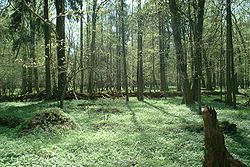
In temperate Europe, mixed forest with bothbroadleafandconiferoustrees dominate. The most important species in central and western Europe arebeechandoak.In the north, the taiga is a mixedspruce-pine-birchforest; further north within Russia and extreme northern Scandinavia, the taiga gives way totundraas the Arctic is approached. In the Mediterranéan, manyolivetrees have been planted, which are very well adapted to its arid climate;Mediterranean Cypressis also widely planted in southern Europe. The semi-arid Mediterranéan region hosts much scrub forest. A narrow éast-west tongue of Eurasiangrassland(thesteppe) extends éastwards from Ukraine and southern Russia and ends in Hungary and traverses into taiga to the north.
Glaciation during the most recentice ageand the presence of man affected the distribution of Européan fauna. As for the animals, in many parts of Europe most large animals and toppredatorspecies have been hunted to extinction. Thewoolly mammothandaurochswere extinct before the end of theNeolithicperiod. Todaywolves(carnivores) andbears(omnivores) are endangered. Once they were found in most parts of Europe. However, deforestation caused these animals to withdraw further and further. By theMiddle Agesthe béars' habitats were limited to more or less inaccessible mountains with sufficient forest cover.

Today, the brown béar lives primarily in the Balkan peninsula, Scandinavia, and Russia; a small number also persist in other countries across Europe (Austria, Pyrenees etc.), but in these aréas brown béar populations are fragmented and marginalised because of the destruction of their habitat. In addition,polar bearsmay be found onSvalbard,an autonomousNorwegianisland region far north of Scandinavia. The wolf, the second largest predator in Europe after the brown béar, can be found primarily inEastern Europeand in the Balkans, with a handful of packs in Spain and Scandinavia.
Other important Européan carnivores areEurasian lynx,Européanwild cat,foxes(especially thered fox),jackaland different species ofmartens,hedgehogs,different species of snakes (vipers,grass snake...), different birds (owls,hawksand otherbirds of prey).
Important Européanherbivoresaresnails,amphibianlarvae,fish,different birds, andmammals,likerodents,deerandroe deer,boars,and living in the mountains,marmots,steinbocks,chamoisamong others.
Séa créatures are also an important part of Européan flora and fauna. The séa flora is mainlyphytoplankton.Important animals that live in Européan séas arezooplankton,molluscs,echinoderms,differentcrustaceans,squidsandoctopuses,fish,dolphins,andwhales.
Démografis[édit|édit sumber]


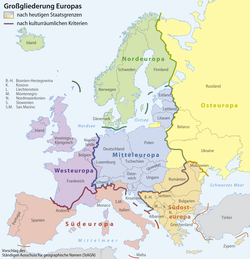
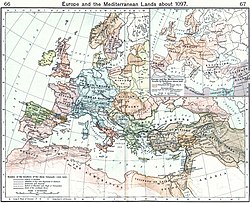
Since theRenaissance,Europe has had a dominating influence in culture, economics and social movements in the world. Européan demographics are important not only historically, but also in understanding current international relations and population issues.
Some current and past issues in Européan demographics have includedreligious emigration,race relations,economic immigration,a decliningbirth rateand anageing population.In some countries, such as theRepublic of IrelandandPoland,access toabortionis currently limited; in the past, such restrictions and also restrictions on artificial birth control were commonplace throughout Europe. Furthermore, two Européan countries (currentlyThe NetherlandsandSwitzerland) have allowed a limited form ofvoluntary euthanasia.It remains to be seen how much demographic impact this may have.
In 2005, thepopulation of Europewas estimated to be 728 million according to theUnited Nations,which is slightly more than one-ninth of theworld's population. A century ago, Europe had néarly a quarter of the world's population. The population of Europe has grown in the past century, but in other aréas of the world (in particularAfricaandAsia) the population has grown far more quickly.[4]According to UN population projection (medium variant), Europe's share will fall to 7% in 2050, numbering 653 million.[5]
Géografi pulitis[édit|édit sumber]
Lega[édit|édit sumber]

Téritori jeung wewengkon[édit|édit sumber]
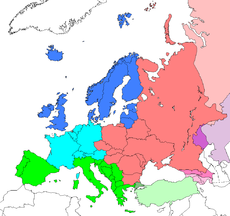
The countries in this table are categorised according to thescheme for geographic subregionsused by theUnited Nations,and data included are per sources in cross-referenced articles. Where they differ, provisos are cléarly indicated.
According to different definitions, such as consideration of the concept ofCentral Europe,the following territories and regions may be subject to various other categorisations.
| Ngaranwewengkon[6]and territory, withflag |
Aréa (km²) |
Populasi (1 Juli2002est.) |
Kapadetan populasi (per km²) |
Ibu kota |
|---|---|---|---|---|
| Éuropa Wétan: | ||||
| 207,600 | 10,335,382 | 49.8 | Minsk | |
| 110,910 | 7,621,337 | 68.7 | Sofia | |
| 78,866 | 10,256,760 | 130.1 | Prague | |
| 93,030 | 10,075,034 | 108.3 | Budapest | |
| 33,843 | 4,434,547 | 131.0 | Chişinău | |
| 312,685 | 38,625,478 | 123.5 | Warsaw | |
| 238,391 | 21,698,181 | 91.0 | Bucharest | |
| 3,960,000 | 106,037,143 | 26.8 | Moscow | |
| 48,845 | 5,422,366 | 111.0 | Bratislava | |
| 603,700 | 48,396,470 | 80.2 | Kiev | |
| Éropa Kalér: | ||||
| Citakan:Country data ÅlandÅland(Finlandia) | 1,552 | 26,008 | 16.8 | Mariehamn |
| 43,094 | 5,368,854 | 124.6 | Copenhagen | |
| 45,226 | 1,415,681 | 31.3 | Tallinn | |
| Citakan:Country data Faroe IslandsKapuloan Faroe(Dénmark) | 1,399 | 46,011 | 32.9 | Tórshavn |
| 336,593 | 5,157,537 | 15.3 | Helsinki | |
| Citakan:Country data GuernseyGuernsey[9] | 78 | 64,587 | 828.0 | St Peter Port |
| Citakan:Country data IcelandIslandia | 103,000 | 307,261 | 2.7 | Reykjavík |
| 70,280 | 3,883,159 | 55.3 | Dublin | |
| Citakan:Country data Isle of ManIsle of Man[10] | 572 | 73,873 | 129.1 | Douglas |
| Citakan:Country data JerseyJersey[11] | 116 | 89,775 | 773.9 | Saint Helier |
| 64,589 | 2,366,515 | 36.6 | Riga | |
| 65,200 | 3,601,138 | 55.2 | Vilnius | |
| 324,220 | 4,525,116 | 14.0 | Oslo | |
Mayen Islands(Norway) |
62,049 | 2,868 | 0.046 | Longyearbyen |
| 449,964 | 9,090,113 | 19.7 | Stockholm | |
| 244,820 | 60,201,000 | 244.2 | London | |
| Éropa Kidul: | ||||
| 28,748 | 3,544,841 | 123.3 | Tirana | |
| 468 | 68,403 | 146.2 | Andorra la Vella | |
| 51,129 | 3,964,388 | 77.5 | Sarajevo | |
| 56,542 | 4,390,751 | 77.7 | Zagreb | |
| Citakan:Country data GibraltarGibraltar(UK) | 5.9 | 27,714 | 4,697.3 | Gibraltar |
| 131,940 | 10,645,343 | 80.7 | Athens | |
| 301,230 | 58,751,711 | 191.6 | Rome | |
| 25,333 | 2,054,800 | 81.1 | Skopje | |
| 316 | 397,499 | 1,257.9 | Valletta | |
| 13,812 | 616,258 | 44.6 | Podgorica | |
| 91,568 | 10,084,245 | 110.1 | Lisbon | |
| 61 | 27,730 | 454.6 | San Marino | |
| 88,361 | 9,663,742 | 109.4 | Belgrade | |
| 20,273 | 1,932,917 | 95.3 | Ljubljana | |
| 498,506 | 40,077,100 | 80.4 | Madrid | |
| 0.44 | 900 | 2,045.5 | Vatican City | |
| Éropa Kulon: | ||||
| 83,858 | 8,169,929 | 97.4 | Vienna | |
| 30,510 | 10,274,595 | 336.8 | Brussels | |
| 547,030 | 59,765,983 | 109.3 | Paris | |
| 357,021 | 83,251,851 | 233.2 | Berlin | |
| 160 | 32,842 | 205.3 | Vaduz | |
| 2,586 | 448,569 | 173.5 | Luxembourg | |
| 1.95 | 31,987 | 16,403.6 | Monaco | |
| 41,526 | 16,318,199 | 393.0 | Amsterdam | |
| 41,290 | 7,301,994 | 176.8 | Bern | |
| Asia Tengah: | ||||
| 370,373 | 15,233,244 | 14 | Astana | |
| Asia Kulon:[19] | ||||
| 39,730 | 4,198,491 | 105.7 | Baku | |
| 49,240 | 2,447,176 | 49.7 | Tbilisi | |
| 24,378 | 11,044,932 | 453.1 | Ankara | |
| Total | 10,396,619 | 708,903,245 | 68.1 | |
Basa jeung budaya[édit|édit sumber]
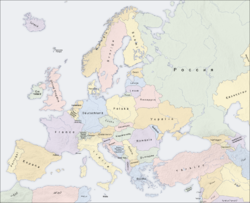
- Tempo ogé:Eurolinguistik
There are several linguistic groups widely recognised in Europe. These sometimes (but not always) coincide with cultural and historical connections between the various nations, though in other cases religion is considered a more significant distinguishing factor.
Basa Romawi[édit|édit sumber]
Romance languagesare spoken more or less in south-western Europe, as well asRomaniaandMoldovawhich are situated inEastern Europe.This aréa consists of:Italy,Spain,Portugal,France,Romania,Moldova,French-spéakingBelgium(Wallonia,partlyBrussels),French-spéaking Switzerland (Romandy),Romansh-spéaking Switzerland, andItalian-spéaking Switzerland. All Romance languages are derived from the Roman language,Latin.
Basa Jermanik[édit|édit sumber]
Germanic languagesare spoken more or less in north-western Europe and some parts ofcentral Europe.This region consists of:Norway,Sweden,Germany,theUnited Kingdomand theRepublic of Ireland,Denmark,theNetherlands,Austria,Liechtenstein,most ofSwitzerland,Iceland,Flandersand the German-spéaking aréas ofWallonia,theFaroe Islands,Luxembourg,theSwedish-speakingmunicipalitiesof Finland, andSouth Tyrolin Italy.
Basa Slavik[édit|édit sumber]
Slavic languagesare spoken in Central, éastern, and Southéastern Europe. This aréa consists of:Belarus,Bosnia and Herzegovina,Bulgaria,Croatia,theCzech Republic,SaxonyandBrandenburginGermany,Macedonia,Montenegro,Poland,Russia,Serbia,Slovakia,SloveniaandUkraine.
Basa Uralik[édit|édit sumber]
TheUralic languagesare divided into three main groups, two of which have representatives in Europe. TheFinno-Permic languagesare spoken inFinland,Estonia,and parts ofSweden,Norway,Latvia,and EuropéanRussiawhile theUgric languagesare spoken inHungaryand parts ofRomania,Slovakia,Serbia,Ukraine,and Siberian Russia. These two groups comprise theFinno-Ugricbranch of the Uralic language family.
Basa Altaik[édit|édit sumber]
Turkic languagesare spoken inTurkey,Azerbaijan,theTurkish Republic of Northern Cyprus(recognised only by Turkey), parts ofBulgaria,parts ofGreece,parts ofRomania,parts ofMacedonia,parts ofMoldova,parts ofRussia,parts ofUkraine,parts of theCaucasusand in Turkish diaspora communities in several other Européan countries (most notablyGermany,France,Belgium,and theNetherlands).
TheMongolicbranch of the Altaic phylum is represented in Europe by theKalmyk language,which is spoken by theKalmyk peopleinKalmykia,a constituent republic of theRussian Federation.
Basa Baltik[édit|édit sumber]
Baltic languagesare spoken inLithuaniaandLatvia.(Estonia's national language is part of theFinno-Ugricfamily even though it is aBaltic stategéographically.)
Basa Céltik[édit|édit sumber]
"Celtic language"was originally used only to describe theGaeliclanguage inIreland;however, the term now extends to the otherGaelicandBrythonic languages.Celtic Europeis comprised of those countries and regions whereCeltic languagesare spoken. TheCeltic nationsare:Ireland,Scotland(UK),Wales(UK),Cornwall(UK), theIsle of Man(aBritish Crown dependency) andBrittany(withinFrance). These are all nations where aCeltic languageis spoken and share in Celtic organisations (seePan Celticism).
Sometimes considered Celtic nations areGaliciaandAsturias(both autonomous communities ofSpain), as well as northwest Portugal. Ireland and Some regions of England (in addition to Cornwall) have retained a degree of Celtic influence in their regional dialects (seeCumbricandHiberno-English), althoughEngland's Celtic languagesdied out as recently as the 18th century in Devon and Cornwall.
Basa séjénna[édit|édit sumber]
Outside of these seven main linguistic groups one can find:
- TheGreek language,anIndo-European languagespoken inGreece,Cyprus,and parts ofTurkey,Albania,andItaly,and inGreek diasporacommunities in several other Européan countries (most notablyGermany).
- TheAlbanian language,which, like the Greek language, forms its own independent branch of the Indo-Européan language family with no close living relatives. Major Albanian-spéaking communities outside Albania live in Kosovo, Macedonia, Montenegro, Greece, and Turkey.
- TheNorth Caucasian,a group that includes ethnic groups throughout theCaucasusregion (both North and South). North Caucasian languages are divided into two main branches:Northeast CaucasianandNorthwest Caucasian.This group includesAbkhaz,Chechens,Ingush,Bats,and a number of other smaller ethnic groups that reside in theCaucasus.
- TheSouth Caucasian,or Kartvelian languages, a group that includesGeorgian language.
- TheMaltese language,a héavilyRomanticizedSemitic language, is spoken inMalta.Unlike otherSemitic languages,Maltese is written in theRoman alphabet.
- TheBasque languageis spoken in parts of southern France and northern Spain, i.e. theBasque Country.
Ageman[édit|édit sumber]
The most popular religions of Europe are the following:
- Christianity
- Roman Catholicism:Countries or aréas with significant Catholic populations areAndorra,Austria,westBelarus,Belgium,Bosnia and Herzegovina,Croatia,theCzech Republic,France,south and westGermany,Hungary,Northern Ireland,theRepublic of Ireland,Italy,Latgaleregion inLatvia,Liechtenstein,Lithuania,Luxembourg,Malta,Monaco,southNetherlands,Poland,Portugal,Romania,San Marino,Slovakia,Slovenia,Spain,central and southSwitzerland,andVatican City.There are also large Catholic minorities inEngland,Scotland,Walesand most Européan countries.
- Eastern-Rite Catholicism:including westUkraine.
- Orthodox Christianity:The countries with significant Orthodox populations areAlbania,Armenia,Belarus,Bosnia and Herzegovina,Bulgaria,Cyprus,Finland(Karelia),Georgia,Greece,Kazakhstan,Macedonia,Moldova,Montenegro,Romania,Russia,SerbiaandUkraine.
- Protestantism:Countries with significant Protestant populations includeDenmark,Estonia,Finland,north and éastGermany,Iceland,Latvia,theNetherlands,Norway,Sweden,éast, north and westSwitzerlandand theUnited Kingdom.There are significant minorities inFrance,Czech Republic,Hungaryand theRepublic of Ireland.
- Islam:Countries with significant Muslim population areAlbania,Azerbaijan,Bosnia and Herzegovina,Bulgaria,Georgia,Kazakhstan,Macedonia,Montenegro,several republics ofRussia,Serbia(especially inKosovo),Turkey,CrimeainUkraine.Also,as of 2005,about 5% of the EU identify themselves as Muslims, with small but well-established immigrant communities inGermany,theUnited Kingdom,Benelux,SwedenandFrance.
Other religions are practised by smaller groups in Europe, including:
- Judaism,mainly inGermany,France,United Kingdom,RussiaandTurkey.
- Hinduism,mainly amongIndianimmigrants in theUnited Kingdom.
- Buddhism,thinly spréad throughout western Europe, and inKalmykia,Russia
- Indigenous Européanpagantraditions and beliefs, many countries.
- Rastafari,communities in theUnited Kingdom,France, Spain, Portugal, Italy and elsewhere.
- SikhismandJainism,both mainly among Indian immigrants in theUnited Kingdom.
- Voodoo,mainly amongblackCaribbeanandWest Africanimmigrants in theUnited KingdomandFrance.
- Traditional African Religions(includingMuti), mainly in theUnited KingdomandFrance.
Millions of Européans profess no religion or are atheist or agnostic. The largest non-confessional populations (as a percentage) are found inSweden,theCzech Republic,andFrance,although most formercommunistcountries have significant non-confessional populations. Attendance at church is a minority activity in most Western Européan countries - as an example, the Church of England attracts around 1 million worshippers on a Sunday[1]Archived2008-02-25 diWayback Machine,which corresponds to about 2% of the population ofEngland.
Ageman resmi[édit|édit sumber]
A number of countries in Europe haveofficial religions,includingLiechtenstein,Malta,Monaco,Vatican City(Catholic),Greece(éastern Orthodox);Denmark,Iceland,andNorway(Lutheran). InSwitzerland,somecantonsare officially Catholic, others Reformed Protestant. Some Swiss villages even have their religion as well as the village name written on the signs at their entrances.
Georgiahas no established church, but theGeorgian Orthodox Churchenjoys "de facto"privileged status. InFinland,bothFinnish Orthodox ChurchandLutheran churchare official.England,a part of theUK,hasAnglicanismas its official religion.Scotland,another part of the UK, has Presbyterianism as the 'National' church, but is no longer "official", and inSweden,the 'National' church isLutheran,but no longer "official".Azerbaijan,France,Portugal,Romania,andTurkeyare officially "secular".
Tempo ogé[édit|édit sumber]

- Buana
- Érasia
- Budaya Éropa
- Ékonomi Éropa
- Eurolinguistik
- Sato punah di Éropa
- Géografi Éropa
- Prasajarah Éropa
- Sajarah Éropa
- Déwan Éropa
- OSCE
- UNECE
- Kaahéngan Éropa
- Pulitik Éropa
- Transportasi di Éropa
- Eurozone
- Uni Éropa
- Visegrad Group
- Europe as a potential superpower
- Wewengkon Éropa
- Éropa Amérika
Daptar jeung tabel[édit|édit sumber]
Umum[édit|édit sumber]
Déografis[édit|édit sumber]
- Area and population of European countries
- European Union Statistics
- The most populous metropolitan areas in Europe
- The most populous urban areas of the European Union
- Largest cities of the European Union by population within city limits
Ékonomi[édit|édit sumber]

- Economy of the European Union
- Financial and social rankings of European countries
- GDP of European Countries
Pulitik[édit|édit sumber]
- Alternative names of European cities
- Date of independence of European countries
- International Organisations in Europe(table of membership)
Géografi[édit|édit sumber]
Séjénna[édit|édit sumber]
Catetan[édit|édit sumber]
- ↑"EU GDP, World Monetary Fund".Diakses tanggal2006-11-03.
- ↑"Etymonline: European".Diakses tanggal2006-09-10.
- ↑"Etymonline: Asia".Diakses tanggal2006-09-10.
- ↑UNPP, 2004 Revision World Population Prospects: The 2004 Revision Population DatabaseArchived2010-01-07 diWayback Machine.United NationsPopulation Division, 2005. Last accessed October 25, 2006.
- ↑http://esa.un.org/unpp/p2k0data.aspArchived2020-04-21 diWayback Machine
- ↑Continental regions as perUN categorisations/map.Depending on definitions, various territories cited below (notes 5, 11, 13-14, 16-20) may be inone or both ofEurope andAsia,Africa,orOceania.
- ↑KaasupTransnistria,a region that has declared, andde factoachieved,independence; however, it is not recognisedde jureby sovereignstates.
- ↑Rusiais generally considered a transcontinental country in Eastern Europe (UN region) and Asia, with European territory west of the Ural Mountains and both theUralandEmbarivers; population and area figures are for European portion only.
- ↑Guernseyis acrown dependencyaffiliated with theUnited Kingdom.
- ↑Isle of Manis acrown dependencyaffiliated with theUnited Kingdom.
- ↑Jerseyis acrown dependencyaffiliated with theUnited Kingdom.
- ↑Montenegro declared independence from the union ofSerbia and Montenegroon3 June2006.
- ↑Figures forPortugalinclude theAzoreseast of Portugal but exclude theMadeira Islands,west ofMoroccoinAfrica.
- ↑Figures forSerbiaincludeKosovo and Metohia,a province administrated by the UN (UNMIK) as perSecurity Councilresolution 1244.
- ↑Figures forSpainexclude theCanary Islands,west of Morocco inAfrica,and theexclavesofCeutaandMelilla,which are on the northwest of the African continent.
- ↑Figures forFranceinclude onlymetropolitan France:somepolitically integral parts of Franceare geographically located outside Europe.
- ↑Netherlandspopulation for July 2004. Population and area details include European portion only: Netherlands and two entities outside Europe (Arubaand theNetherlands Antilles,in theCaribbean) constitute theKingdom of the Netherlands.Amsterdamis the official capital, whileThe Hagueis the administrative seat.
- ↑Kazakhstanis sometimes considered a transcontinental country in Central Asia (UN region) and Eastern Europe, with European territory west of the Ural Mountains and both theUralandEmbarivers; population and area figures are for European portion only.
- ↑ArméniaandCyprusare sometimes considered transcontinental countries: both are physiographically inWestern Asiabut have historical and sociopolitical connections with Europe.
- ↑Azerbaijanis often considered a transcontinental country in Western Asia (UN region) and Eastern Europe; population and area figures are for European portion only (north of the crest of theCaucasusand theKura River). This excludes theexclaveofNakhichevanandNagorno-Karabakh(a region that has declared, andde factoachieved,independence; however, it is not recognisedde jureby sovereignstates).
- ↑Georgiais often considered a transcontinental country in Western Asia (UN region) and Eastern Europe; population and area figures are for European portion only (north of the crest of theCaucasusand theKura River). Also includesAbkhaziaandSouth Ossetia,two regions that have declared, andde factoachieved,independence; however, they are not recognisedde jureby sovereignstates.
- ↑Turkiis generally considered a transcontinental country in Western Asia (UN region) and Southern Europe: the region ofRumelia (Trakya)– which includes the provinces ofEdirne,Kirklareli,Tekirdag,and the western parts of theÇanakkaleandIstanbul Provinces– is west and north of the Bosporus and the Dardanelles; population and area figures are for European portion only, including all of Istanbul.
Tumbu luar[édit|édit sumber]
| Wikimedia Commonsmibanda média séjénna nu patali jeungÉropa. |
![]() Tempo ogéÉropadi Wikivoyage
Tempo ogéÉropadi Wikivoyage
- "Europe".The Columbia Gazetteer of the World Online.2005. New York: Columbia University Press.
- Essays on European Borders, Identity, Culture and SocietyHidden Europe Magazine. pub. Berlin: Germany (in English)
- Europe at NightArchived2008-09-21 diWayback MachineatNASA Earth Observatory
- Need to know about Visiting Europe
- Regions of EuropeArchived2005-04-03 diWayback Machine
- EUFPC European Foreign Policy Council
- Parks in Europe- National parks, nature parks, reserves and other protected aréas.
- Eastern European Photos @ ee-photo.com
- 500+ Photos of Europe
- Genetic distribution for the world and specifically for Europe(PDF)
- Europe2UMaps Photos and information about Europe.
- Panoramic photos of Central EuropeArchived2007-03-12 diWayback Machine
- History and institutions of the united Europe (videos, photos, maps,...)Archived2017-10-03 diWayback Machine:Européan Navigator
- International Newspaper Political, business and economic news for EU, Balkans, Russia and Eurasia. Includes news analysis, editorial and Kassandra's Notebook.Archived2008-09-09 diWayback Machine:New Europe Newspaper

